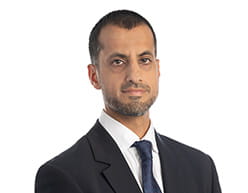The UAE construction industry has been a major contributor to the nation's overall economy since the 1990s. As we celebrate the 30th anniversary of the opening of Trowers & Hamlins LLP's Abu Dhabi office, Hasan Rahman and Yuen Phing Choo from our International Construction team briefly chart the urban development of Abu Dhabi and the evolution of its construction industry over the same period, while identifying some key themes which are likely to affect the Abu Dhabi construction market over the next decade.
Since it was officially made the permanent capital of the UAE in 1996, the urban landscape of Abu Dhabi has been transformed as a result of numerous major construction and infrastructure projects.
From its original design in the 1960-70s as a small to midsize city to support the nascent UAE oil and gas industry, Abu Dhabi has developed into a global capital and centre for tourism and commerce.
One only needs to look at photographs of Abu Dhabi city in 1993 when Trowers officially opened its Abu Dhabi office to appreciate the scale of construction which ensued through the next 3 decades. The Abu Dhabi of 1993 was a much smaller city located almost entirely on the main island, with the large modern towers and shopping malls now spread across Abu Dhabi and entire islands such as Reem, Saadiyat and Yas yet to be developed.
Iconic Projects that shaped the skyline (1990s to present)
Between 1990 to 2000, the Abu Dhabi government implemented a comprehensive development master plan for the Emirate expanding the existing city to its neighboring islands and towards the mainland along the highways to Dubai and al Ain. Abu Dhabi Island's major malls and hotels began to open in the early 2000s, followed by the iconic Sheikh Zayed Grand Mosque in 2007.
In 2007, the Abu Dhabi government published Plan Abu Dhabi 2030 (the Urban Structure Framework Plan) which set the agenda for Abu Dhabi's future urban development. Plan Abu Dhabi 2030 encouraged the reshaping of the city's skyline through the development of tall buildings, particularly in the central business district and the new developments on Al Maryah Island and Al Reem Island. The subsequent urban development has seen the expansion of Abu Dhabi through the launch of new urban centres and mixed-use communities, including Masdar City (the world’s first zero-carbon city), Saadiyat Island (with its cultural, residential and marina districts), Yas Island (with its leisure and recreational facilities and residential offerings), Reem Island, Al Maryah Island and now new megaprojects under construction on Jubail Island and Hudayriat Island. Just over 15 years on from the publication of Plan Abu Dhabi 2030, Abu Dhabi's city skyline is full of glittering new towers and the city has undergone massive and rapid change, growing from a metropolitan area population of just over 350,000 in 1993, to almost 1,570,000 in 2023.
Abu Dhabi's construction industry
The early phases of Abu Dhabi's urban development over the past 30 years were undertaken by the government and various UAE family conglomerates. Since the mid-2000s, a mix of economic diversification and public sector investment has led to the development of numerous opportunities for construction and engineering companies to deliver megaprojects in Abu Dhabi, which led to an influx of international contractors. Far Eastern contractors had arrived in Abu Dhabi after the Asian financial crisis of the late 1990s and the past 20 years have generally seen Asian contractors dominate the UAE's construction sector for major projects (particularly in the infrastructure and transport sectors), though European firms also began to bid aggressively for work in the early 2010s after the global financial crisis.
However, the rapid urban development and transformation of Abu Dhabi over the past 30 years has not always meant a healthy construction industry, as evidenced by high profile contractor failures such as those of Arabtec, Drake & Scull and Carillion and several international contractors such as the UK’s Balfour Beatty, Netherlands-based Bam International, and South Africa’s Murray & Roberts choosing to exit the UAE market.
Even before the Covid-19 pandemic, the Abu Dhabi construction industry was facing major challenges, including low profit margins, delayed payments and projects, latency in technology adoption and high amounts of waste in the form of time, costs and effort. In many ways, the current Abu Dhabi construction market over the past decade has been (and still remains) reminiscent of the UK construction industry in 1990s, when the Latham Report commissioned by the UK government identified key systemic issues of concern plaguing the construction industry, principally:
- an adversarial approach to contracting and consequent lack of collaboration between stakeholders;
- a lack of innovation in procurement and technology;
- a "race to the bottom" culture in project tendering; andnegative and/or interrupted cashflows down the supply chain, all of which led to a large number of claims, delays and disputes on projects and threatened the financial solvency of construction companies.
However recent Abu Dhabi government initiatives to diversify the economy away from oil and gas and strengthen Abu Dhabi's position as a world class leisure, retail, and tourism destination, and to improve liveability for Abu Dhabi's growing population has provided significant opportunities for the Abu Dhabi construction sector. At the time of writing we are witnessing renewed confidence in all segments of the Abu Dhabi construction market (commercial, leisure and tourism, industrial, transport and civil infrastructure, energy and utilities and residential), in part due to steps the government has recently taken to invest in and promote new technologies, address late payments, and increase domestic firms’ participation in and benefits from construction supply chains.
Future trends - from expansion to sustainability
The rapid urbanisation required to accommodate the massive influx of people into Abu Dhabi over the past 30 years inevitably pushed liveability and sustainability down the construction industry's agenda. This is now changing: after two decades of growth driven by huge government capital spending, rising real estate demand, and investment in infrastructure, Abu Dhabi's future development will be shaped by the need for more private sector financing, greater energy efficiency, greater liveability for a diverse and growing population, and lower carbon emissions. As a consequence, the drivers of construction in Abu Dhabi’s next phase of development will be very different to what came before.
We believe that the following 5 key trends will shape the medium-term future of the Abu Dhabi construction industry:
- The emphasis on the decarbonisation of projects, both in construction and operation, in line with the UAE's pledge to move towards achieving net-zero emissions by 2050 targets will undoubtedly contribute to reshaping the construction industry of Abu Dhabi. Projects will be required to minimise their carbon footprint and contractors and suppliers will be assessed and incentivised by their contribution to these targets.
- Asset performance (i.e. maximising the capacity of the assets to deliver revenues, while reducing operation and maintenance costs) will increasingly become a key performance metric alongside PPP models such as design-build-operate schemes, and/or retrofit projects. The industry's shift towards sustainability, technical performance and maximising energy conservation measures will see a rise in the demands for smart buildings / cities and infrastructure that offer real-time tracking of asset performance and greater flexibility of space, and we will continue to see new opportunities for energy services companies through the growth of ESCO and super-ESCO schemes.
- We will see a shift from traditional government procured real estate projects towards privately financed infrastructure and transport schemes, as the government seeks alternative financing mechanisms such as public private partnerships (PPP) to deliver projects. This will provide significant opportunities for developers and contractors who can bring a combination of finance (including through export credit agencies) and technical capability (both in construction and operation) to the table.
- We will see increasing emphasis on localisation and in-country value strategies, in part to stimulate the local economy and local employment, but also as a result of procurers and developers increasingly seeking shorter and more resilient supply chains to reduce dependence on external suppliers and retain greater quality control.
- We will see a move towards greater collaboration, more equitable risk sharing, increased sophistication in procurement, and greater emphasis on maintaining cashflow through supply chains – each of these factors will enhance the robustness and efficiency of the construction industry. There appears to be a growing realisation that industry players will need to move away from the status quo to improve cashflow, reduce the prevalence of costly and disruptive disputes, promote collaboration and efficiency, and incentivise innovation and performance. To address these concerns, ideas such as government legislation to adopt some of the key principles introduced by the UK Construction Act and a government-monitored playbook adopting these principles in a similar manner as the UK's Construction Playbook are gaining traction within the local construction industry.
It is hoped that these key trends will modernise the local construction industry and lead to a culture of collaboration, technological progress, innovation, and sustainability. In an age of artificial intelligence, robotics, the internet of things, virtual and augmented reality, and Big Data, it is time for the construction industry and its supply chains to embrace and implement new technologies that will improve productivity and reduce costs.
This culture shift would improve the efficiency and output of the industry as projects become larger and more complex, and factors such as sustainability, liveability, asset life cycles and environmental standards are placed at the forefront of the industry's agenda.
Sources:
- Plan Abu Dhabi 2030, Urban Structure Framework Plan by the Abu Dhabi Urban Planning Council
- The Evolution of Abu Dhabi City's Urbanisation and the Sustainability Challenge by Kais Samarrai
- Construction Megatrends; Analysing the trends that will share the next decade of UAE construction by mashreq partnered with MEED
- Construction Week Online

